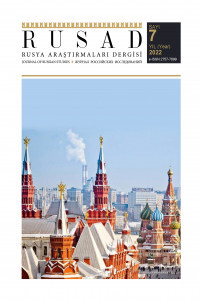Bir Panslavizm Çeşidi Olarak Austroslavizm (1848-1849)
Bu makalede 1848-1849 Devrimleri dönemi temel alınarak Habsburg Slavlarının federalizm ilkesi temelinde geliştirdikleri Austroslavizm düşüncesinin politik programı anlatılacaktır. Austroslavizm düşüncesi Çek düşünür ve politikacılar tarafından formüle edilmiş ve Orta Avrupa Slavlarının federal bir şekilde düzenlenecek Habbsurg Monarşisi içinde kurulacak ayrı bir federe birim altında toplanarak Alman ve Rus yayılmacılığına karşı kendilerini savunmalarını amaçlamıştır. Bu bakımdan çalışmada sırasıyla önce Alman düşünürlerin perspektifinde Orta Avrupa kavramının ne anlama geldiği açıklanırken daha sonra Habsurg Monarşisi Slavlarının geliştirdiği Austroslavizm düşüncesi ve politik programı incelenecektir. Bu bağlamda Austroslavizm programının geliştirilmesinde önemli bir rol oynayan Çek düşünür František Palačky’nin görüşlerine yer verilecektir. Almanların ve Habsburg Slavlarının Orta Avrupa kavramını nasıl düşündükleri konusundaki farklılıkları tarihsel bağlam içerisinde dönemin düşünür ve politikacıların ortaya koyduğu programlar çerçevesinde gösterilecektir. Çalışma XIX. yüzyılda Habbsurg Slavlarının oluşturduğu Austroslavizm programının günümüzde Avrupa Birliği içinde hâlâ Slav ulusların izlediği politikalar bakımından da bir temel oluşturduğu şeklinde bir iddia da ortaya atmaktadır.
Anahtar Kelimeler:
Habsburg Monarşisi, Austrolavizm, Panslavizm, federalizm, milliyetçilik, Rusya
Austroslavism as One of the Types of Panslavism (1848-1849)
In this article, the political program of the Austroslavism thought developed by the Habsburg Slavs based on the principle of federalism, which was important during the Revolution of 1848-1849, will be explained. The first people to come up with the idea of Austroslavism were Czech politicians and thinkers. Within the framework of Austroslavism's political program, the main goal was for Central European Slavs to unite under a separate federated administrative structure within the Habsburg Monarchy. This means that it had to be set up federally, and Central European Slavs would use this structure to protect themselves from German and Russian expansionism. Austroslavism was mostly adopted by Czechs, Slovaks, Slovenes, and Croats, who had no other country of origin than the Habsburg Empire. In this case, other Slavic countries, like the Poles, Serbs, and Ukrainians, who lived inside the Habsburg Monarchy but also had their own countries outside of it, tied their hopes for freedom to the independence of their countries. So, there wasn't much political support for the Austroslavism plan among these three countries. Most Czech, Croatian, Slovak, and Slovenian intellectuals and politicians have been in favor of the Austroslavism program. For the Austroslavists, the main aim was to protect their "small nation" from German and Russian oppression and to keep building their nation within the (con)federalized Habsburg state. Because of this, these "small nations" built their ideas about Central Europe around the ideas of Austroslavism. For this reason, these "small nations" have shaped their Central European concept within the framework of Austroslavism thought. In the study, firstly, what the concept of Central Europe means from the perspective of German thinkers will be explained, and then the thought and political program of Austroslavism developed by the Slavs of the Habsburg Monarchy will be examined. In this context, the views of the Czech thinker František Palačky, who played an important role in the development of the Austroslavism program, will be indicated first, and the different Central European concepts put forward by the Germans and the Habsburg Slavs will be shown.
Keywords:
Habsburg Monarchy, Austroslavism, Panslavism, federalism, nationalism, Russia,
___
- Aydın, Mithat. “Bosna-Hersek Ayaklanması (1875)’nda Panslavizmin Etkisi ve Sırbistan ve Karadağ’ın Rolü.” Belleten 69 (2005): 913-936.
- Beneš, Vojta. The Vanguard of the “Drang Nach Osten.” Chicago, Illinois: Czechoslovak National Council of America, 1943.
- Cipek, Tihomir. “Ideja Srednje Europe František Palackog.” Časopis za Suvremenu Povijest 36/2 (2004): 597-607.
- Cipek, Tihomir. “Mitteleuropa. Prilog Povijesti Germanski Ideja Srednje Europe do 1919. Godine.” Politička Misao: Časopis za Politologiju 34/1 (1997): 154-166.
- Demir, Hakan. “Polonyalı Hotel Lambert ve Büyük Sırbistan “Načertanije” Planı (1840-1844).” Avrasya İncelemeleri Dergisi II/1 (2013): 271-310.
- Demir, Hakan. “Hırvat Politikacı Stjepan Radić’in (Kon)Federal Orta Avrupa Programı.” Balkan Araştırma Enstitüsü Dergisi 4/1 (2015): 19-40.
- Diec, Joachim. “Russian Panslavizm and its Concept of Europe.” L’Europa dei nazionalisti: Prospettive storiche. Ed. Franco Angeli. (2020): 113-124.
- Džoić, Dragomir. “Austroslavizam, Federalizam, Jugoslavizam Biskupa Josipa Jurja Strossmayera i Narodne Stranke”, Pravni Vjesnik 3-4, (1999): 401-417.
- Eberhardt, Piotr. “Polski Panslawizm Jako Idea Geopolityczna.”, Przegląd Geopoliticzny Tom 7 (2014): 61-84.
- Fiecko, Jerzy, “Central Europe In Mickiewicz’s Thought And Deed During The European Revolution (1848-1849). The Croatian Troops.” Pannonia: Časopis za Humanističke Znanosti 2/1-2 (2018): 45-58.
- Fulbrook, Mary. Almanya’nın Kısa Tarihi. Çev. Sabri Gürses. İstanbul: Boğaziçi Üniversitesi Yayınevi, 2011.
- Gangó, Gábor. “1848-1849 in Hungary.” Hungarian Studies, 15/1 (2001): 39-47.
- Hawes, James. Kısa Almanya Tarihi. Çev. Yavuz Alogan. İstanbul: Say Yayınları, 2019.
- Hroch, Miroslav. Avrupa’da Milli Uyanış. Çev. Ayşe Özdemir. İstanbul: İletişim Yayınları, 2011.
- Kohn, Hans. Panslavizm ve Rus Milliyetçiliği. Çev. Agâh Oktay Güner. İstanbul: İlgi Kültür Sanat Yayıncılık, 2007.
- Markus, Tomislav. “Federalizm i Konfederalizam u Tekstovima Slavenskog Juga 1848.-1850.” Povijesni Prilozi 13/13 (1994): 111-137.
- Markus, Tomislav. “Mađarski Nacionalizam i Hrvatska Politika 1848.-1849.” Časopis za Suvremenu Povijest 29/1 (1997): 41-66.
- Pech, Stanley Z. The Nationalist Movement of Austrian Slav in 1848: A Comparative Sociological Profile.” Historie Sociale/Social History (1976): 336-356.
- Švoger, Vlasta. “Recepcija Herdera u Hrvatskome Naradnom Preporodu na Temelju Danice Ilirske.” Časopis za Suvremenu Povijest 3. (1998): 455-478.
- Yayın Aralığı: Yılda 2 Sayı
- Başlangıç: 2019
- Yayıncı: Tekin Aycan TAŞCI
Sayıdaki Diğer Makaleler
“Ak Altın”ın Kara Kaderi: Pamuk Vakası ve Şeref Reşidov’un Başına Gelenler
1741 İhtilâlı ve İngiltere’nin Rusya Politikasının İflası
Birinci Dünya Savaşı Arifesinde ve Esnasında Rus Donanması ve Karadeniz Boğazları
Kirill NAZARENKO, Çevirmen: Alperen KÜÇÜKDAĞDELEN
Russia Abroad, A Cultural History of the Russian Emigration 1919-1939
Bir Panslavizm Çeşidi Olarak Austroslavizm (1848-1849)
